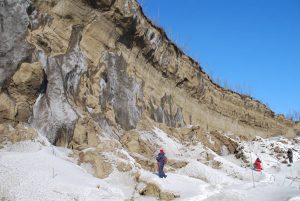Oldest permafrost in Siberia discovered

While determining the age of a permafrost layer in Siberia, an international team of experts set a new record: at its deepest point, the soil is at least 650,000 years old. Yet the team’s findings, just published in the magazine Quaternary Research, also reveal how sensitive the soil is to disturbances – and how quickly it can be destroyed.
An international team of researchers has now dated the oldest known permafrost in Siberia. The permafrost layer, located near the eastern Siberian village of Batagay, has been frozen in a depth of ca. 50 metres for the past 650,000 years – a record. “That means this permafrost layer has already survived several glacial and interglacial periods,” says geographer Dr Thomas Opel from the Alfred Wegener Institute, Helmholtz Centre for Polar and Marine Research (AWI) in Potsdam. This finding is relevant because it shows that, even during warmer periods, permafrost doesn’t necessarily have to thaw entirely. For example, the permafrost in Batagay apparently survived a particularly warm phase roughly 130,000 years ago, when it was four to five degrees Celsius warmer in the Arctic summer than today. Permafrost refers to soil and rock that is permanently frozen, in some cases to a depth of several hundred metres. It is chiefly found in North America and Siberia, but also in mountain ranges, and, like a massive deep-freeze, preserves tremendous amounts of dead biomass, primarily plant matter but also the remains of fauna from the last ice age, like mammoths and woolly rhinoceroses. When permafrost thaws, it activates bacteria that begin breaking down the ancient biomass and, through their metabolic processes, release the climate-relevant gases carbon dioxide and methane; the more intensive the thawing, the more gas is released. With regard to the on-going climate change, experts fear that this aspect could worsen the greenhouse effect.
Under favourable conditions, more robust than previously assumed
Accordingly, the findings that the team has now published in the magazine Quaternary Research are of major importance. They show that, at consistently low ground temperatures, extremely old and deeply buried permafrost can survive naturally occurring warmer periods, whereas the permafrost elsewhere undergoes massive thawing, especially near the surface. At the same time, however, the situation near Batagay demonstrates how sensitive permafrost is to anthropogenic disturbances. The 650,000-year-old permafrost is located on a hillslope at a depth of ca. 50 metres, where the temperature remains stable at minus 10 degrees Celsius. But, from the 1940s to the 1960s, the slope was partly cleared, and used by heavy tracked vehicles as a road to reach a nearby mine. In the process, it lost its protective and insulating plant cover. As a result, the younger permafrost began thawing near the surface in summer, until the ground finally began sliding away, uncovering the older permafrost. For years, meltwater has transported the thawed material downhill, forming a large crater that is now up to 50 metres deep. In addition, the cliff continues to erode at a rate of up to 30 metres per year.
Combining a range of analytical methods
The team, which included German, Russian and English researchers and was led by Prof Julian Murton from the University of Sussex, explored the permafrost from the upper end of the cliff to its base, using a range of methods to precisely determine the age of the permafrost at various depths. For example, luminescence dating was used to determine when the quartz and feldspar grains found in sand at various depths were covered by subsequent layers, making it the last time they were exposed to sunlight. In contrast, experts from the Helmholtz-Zentrum Dresden-Rossendorf measured the concentration of radioactive and stable chlorine in the ice samples using highly sensitive accelerator mass spectrometry. This approach makes it possible to directly measure the age of the ice, which forms long wedges in the permafrost in the course of millennia.
In addition, isotopes of certain chemical elements were measured. Isotopes are atoms that contain different numbers of neutrons and therefore have different weights. There are, for example, three naturally occurring isotopes of oxygen – 16O, 17O and 18O – two of which Thomas Opel and his team used for their analyses. 18O has two more neutrons than 16O, making it heavier. In the course of interglacial and glacial periods, the relative concentrations of 16O and 18O isotopes in the ice of glaciers and permafrost change, making it possible to deduce the prevailing climatic conditions and, indirectly, the ages of the respective permafrost layers and the ice they contain.
“The dating results from Batagay impressively show how stable permafrost can be, managing to survive for hundreds of thousands of years,” says Thomas Opel, “but also how sensitive it is to disturbances.” Once the damage is done, it’s irreparable, because the exposed permafrost thaws even more with every summer. Over the past 50 years, the ‘megaslump’ has grown to a width of ca. 900 metres.
Recently launched joint project
The potential that the ancient permafrost in Batagay holds for reconstructing the climatic and environmental conditions in past eras is the subject of a joint research project recently launched by the AWI in Potsdam and Northumbria University, England. The project, sponsored by the UK-based Leverhulme Trust, will investigate under which climatic conditions in the geological past the Siberian permafrost formed, remained stable, or degraded. This information is important for predicting the future development of the permafrost as climate change progresses. Both the AWI Potsdam’s past and future efforts concerning Batagay are especially based on long-standing collaborations with the Melnikov Permafrost Institute and North-Eastern Federal University in Yakutsk.
Original publication
Julian B. Murton, Thomas Opel, Phillip Toms, Alexander Blinov, Margret Fuchs, Jamie Wood, Andreas Gärtner, Silke Merchel, Georg Rugel, Grigoriy Savvinov and Sebastian Wetterich: A multi-method dating study of ancient permafrost, Batagay megaslump, east Siberia. Quaternary Research (2021); DOI: 10.1017/qua.2021.27
source: AWI






Schreibe einen Kommentar